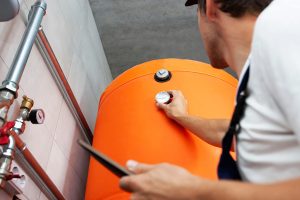Tips for Buying a House with Oil Central Heating
Did you know there are more than one million households in the UK with oil central heating? If you’re thinking about moving to an off-grid area, it’s likely your new home will be powered by an oil-fired boiler.
Read on to discover our expert advice on buying a property with an oil central heating system.
What Are Off-Grid Homes?
Off grid homes often exist in rural locations and need to seek alternative forms of fuel. ‘Traditional’ properties run by extracting natural gas from a mains gas grid. Some more modern homes may use renewable energy, but for those in a remote area, home heating oil is effective and energy-efficient.
These homes have a heating oil tank installed. The tanks contain kerosene, which burns efficiently through oil central heating to warm up water and power radiators. In many cases, this kind of heating system is cheaper than gas or electricity.
What to Consider When Buying a Home with Oil Heating
If you’re thinking about buying a new home with oil heating, there are some factors to consider. There are costs involved however you heat your home, so be mindful before you commit.
Does the Home Already Have Oil Storage Tanks Installed?
If the property doesn’t yet have an oil tank or would benefit from an upgrade, this will increase your costs. Typically speaking, the average cost of installing an oil tank is between £1,000 and £2,000, depending on the size, oil suppliers and location.
Oil tanks can vary from as little as 500 litres to 10,000, so this will affect the cost. The average UK household gets through around three 500-litre oil tanks per year. Your oil levels will vary depending on how many people live in your home and how much energy they use.
How Old is the Existing Oil Heating System?
If you’re considering buying a home with an oil tank and oil boiler, it’s important to check how old they are. All appliances go through wear and tear, so if they’re not properly maintained, this may result in breakdowns.
Look for a serial number on your oil boiler. The third and fourth numbers indicate the year it was made. For example, a 0 and a 9 suggest it was made in 2009. Oil tanks may also have serial numbers, but you can ask a technician to verify this if you’re not sure.
Generally, oil boilers last between 10 and 15 years, while oil tanks will manage up to 20 years. They can be prolonged with regular maintenance (at least once a year) and with fuel topped up – ideally no less than ¼ of a tank.
Learn about our trusted oil boiler servicing designed to prevent future breakdowns.
What Kind of Oil Tank Do I Need?
If it’s your first time installing an oil tank, remember there are lots of options. You’ll have to abide by certain building regulations, depending on the size of the tank and your location. Tanks with a capacity of more than 2,500 litres must be ‘bunded’ by law. This means they have a second outer layer to contain leakages.
Oil tanks can come bunded or ‘single-skinned’. They can also be steel or plastic. Generally, plastic and single-skinned tanks are cheaper, but steel lasts longer and may be more resistant to weather damage. If your oil tank is less than 2,500 litres, it may also need to be bunded if:
- It’s within 10 metres of a controlled water source
- It’s within 50 metres of a borehole or spring
- It’s near an open drain or loose manhole cover
- It’s on hard ground that could make spillages into controlled water sources easier
- It’s supplying fuel to more than just your home.
Where Do I Need to Put My Heating Oil Tank?
Homeowners also need to comply with building regulations when planning where to put their oil tank. First, it needs to be on a flat surface to avoid the risk of spillage. It also needs to be accessible to delivery drivers. This is especially important in winter months when weather may be bad.
All oil tanks need to be 1.8 metres away from:
- Non-fire related eaves of a building (where the roof extends beyond the main building)
- Non-fire building or structures such as greenhouses and garden sheds
- All openings in a fire-rated building or structure, such as doors and windows in a brick house or garage.
They also need to be 760mm away from a non-fire rated boundary, like a wooden fence, and 600mm away from screening that is not part of the boundary, such as trees and shrubs.
Ideally, your delivery driver shouldn’t have to drag a hose through your home. The oil tank should be accessible by going around the property.
How Can I Set Up Oil Deliveries?
You can speak to our expert team to set up cost-effective deliveries. Keep in mind that oil prices are lower in summer, so it’s best to pre-order to keep your heating bills low. You can also ask for a smart monitor, which allows you to check your oil levels and even automate booking deliveries.
We’ll help you find an OFTEC-registered engineer to deliver fuel at a time that suits you.
How Can I Check My Oil Levels?
There are many ways to check the oil level in your tank, from the traditional to the modern. You can use a ‘dipstick’ similar to how you would in a car, or look at the mechanical float gauge on the side of your tank.
The best way is to use a smart oil monitor. These cost around £6 per month and have built-in security measures to stop you running out. It’s important to be vigilant rather than waiting for your central heating system to break down!
This is also a good argument for regular inspections, which prolong the lifespan of your pipework, oil boiler and storage tanks. If you discover unexpected changes like hot water running out faster, it could be a sign there’s a problem. Regular maintenance and your smart app’s functionality can stop this happening.
Contact Us if You’re Buying a Home with Oil Heating
Ready to take the leap into the cost-effective world of home heating oil? Speak to our experts for installations, top ups and advice today.





